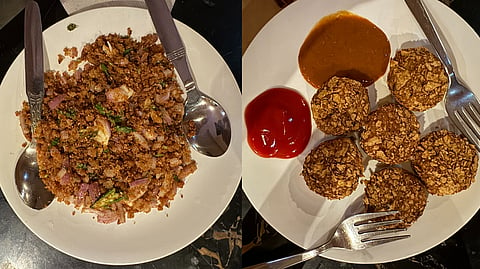

The Malayalis have a sensuous term for it – "touchings". So much more sophisticated than the North Indian "Chakna". But Bar snacks by itself can be a distinct food genre. Within that Indian "munchies" are in a different league altogether. I believe there is a reason for it. Liquor in India was seldom enjoyed for flavour or aroma (though Cashew Feni lovers may protest). In fact, most traditional Indian spirits – with the exception of a few like Asha made by the Rajasthan Royals – tasted quite terrible. This was true even for the so-called Indian Made Foreign Liquor (IMFL) which was made usually from distilled molasses. No amount of synthetic flavonoids could mask the basic character of sugarcane ethanol. Besides, there was no concept of ageing and curing. So drinkers felt the need to have something spicy (and, often oily as in fried) to cut through the sharpness of the alcohol.
I suspect there were some other theories at play. The first is the ‘empty stomach’ principle. There is partial merit in it. If one drinks after not having eaten for a long time, the body - starved of sugar - absorbs alcohol at a faster pace and that can cause early intoxication. However, the presumptions that it causes acidity or attacks the liver are both flawed. Intake of fried and oily stuff can indeed aggravate acidity problems besides putting greater load on the liver to process fats and sugar. Then there is the belief that protein neutralises the impact of alcohol. This probably explains the Punjabis' love for Chicken Tandoori and Paneer Tikkas with their Desi "Scotch". But it is unfair to single them out because across India there is a natural association between liquor and non-vegetarian appetisers.
Indian drinkers also have a fascination for goat liver. Perhaps, this too is based on the intent of providing sustenance to their own overworked organ. This may have some scientific basis as goat liver is high on protein and low on cholesterol and fats. Besides it is loaded with vitamins including vitamins particularly B12 and folate which should be beneficial for those given to heavy drinking. I have greater trust in this logic because I have seen liver being a favourite pairing with country liquor and other local hooch like Mahua. In fact, the best liver I remember having was in our college days at a Santhali Handia shack near Ghatshila enroute to Ranchi. Those were tiny bits sauteed with a surfeit of turmeric, onion and chillies. Even now I find liver is popular at down market watering holes where one also gets other parts of goat intestines. In tribal areas, these are replaced with the innards of chicken like the gizzards. This, to my mind, meets the twin objectives of cancelling the aftertaste of alcohol while providing nutritional supplement.
Good bars usually have their signature bar snacks that are as much of a draw as the ambience of the place. These are generally regional specialities like the beef and fish preparation in Kerala. But the Toddy Shops in the big cities of Kerala such as Ernakulam have probably carried it too far. Some are now more popular for their food rather than the liquor and have become tourist traps. At honest bars, alcohol is the hero and food is only a supporting cast. They do not allow food to take the centre stage and become a distraction cutting down the consumption of its main revenue earner, namely booze.
The best such example I know of is Shaw’s Bar (more popularly called Chota Bristol) in Kolkata’s Dharmatala, in the lane next to the old Metro cinema. They don’t have a kitchen of their own but let approved street vendors come in with items kept on small paper bowls on a tray. Customers take their pick against cash. The items range from sprouted bean salad, green guava chaat, fried chilli chicken, fish fingers, boiled eggs and, of course, fried liver.
The old colonial clubs too have their traditional bar eats. Though the history of the Bhubaneshwar Club does not date back to the days of the Raj, on a fleeting visit there last week, I discovered the unique Papdi Kabab. These are patties made of chenna or paneer but fried with a coating of crushed Papad. Looking at it another way, they combine the goodness of paneer tikka with the tanginess of papad. However, the heart stealer for me was the bori-chura. Roasted and crumbled sun-dried Dal Vadi (lentil dumplings) mixed with onion, green chillies, garlic and tempered with raw mustard oil. It was reminiscent of the Sukuti Sadheko (smoked and dried meat salad) which one has in Nepal prepared in much the same way. Another equivalent of this could be the Goan or Konkani dried prawn Kismur.
As the younger generation gets more discerning about taste and coarse liquor makes way for Single Malts, Aromatic Gins and fine wines - "touchings" could soon be a part of food nostalgia. On the other hand, they have the potential to be turned into exotoc and nouvelle bar eats like Tapas in the hands of innovative new-age master chefs.
ALSO READ | To Manipuri Meitei food, with love
Subtle and sophisticated, Kashmiri food has all it takes to become a hit
Giving the underrated pulao its due
Whose Butter Chicken is it anyway?
O Pedro: Where the spirit of Julie is alive and well
From the Bengali machher jhaal to the Mangalorean gassi, the pomfret is the star of fish curries
Bacon and ham have caught pork lovers' fancy in India -- but sausages are not far behind
Call it poha, aval or chira, this comfort food's popularity knows no bounds
A taste of Awadh in Jaipur and Kolkata
Famous in China, duck meat is one of India's underrated regional dishes
Bhim cooked it, Lord Ram relished it: India's gift to the world is the humble dal
(Sandip Ghose is an author and current affairs commentator. He tweets @SandipGhose.)